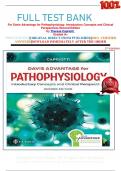FULL TEST BANK
For Davis Advantage for Pathophysiology: Introductory Concepts and Clinical
Perspectives Second Edition
by Theresa Capriotti
Graded A+
PRINTEND PDF|ORIGINAL DIRECT FROM PUBLISHER|100% VERIFIED
ANSWERS|DOWLOAD IMMEDIATELY AFTER THE ORDER
2TH EDITION
Complete Test Bank, All Chapter Are Included
For More Documents Search (Testbankproferssor.Stuvia)
,Table Of Contents
Chapter 1, The Cell In Health And Illness .................................................................................................................................. 3
Chapter 1, Answer Section....................................................................................................................................................... 11
Chapter 2: Cellular Injury, Adaptations, And Maladaptive Changes ........................................................................................ 25
Chapter 2: Answer Section........................................................................................................................................................ 33
Chapter 4: Stress, Exercise, And Immobility ............................................................................................................................ 46
Chapter 4 Answer Section ........................................................................................................................................................ 54
Chapter 5: Obesity And Nutritional Imbalances ....................................................................................................................... 66
Chapter 5: Answer Section ....................................................................................................................................................... 70
Chapter 6, Pain .......................................................................................................................................................................... 82
Chapter 6, Answer Section ........................................................................................................................................................ 87
Chapter 7, Fluid And Electrolyte Imbalances ......................................................................................................................... 100
Chapter 7, Answer Section...................................................................................................................................................... 106
Chapter 8, Acid–Base Balances .............................................................................................................................................. 120
Chapter 8, Answer Section...................................................................................................................................................... 129
Chapter 9, Infection And Inflammation .................................................................................................................................. 142
Chapter 9, Answer Section...................................................................................................................................................... 149
Chapter 10, Infectious Diseases .............................................................................................................................................. 164
Chapter 10, Answer Section .................................................................................................................................................... 168
Chapter 11, Disorders Of The Immune System ...................................................................................................................... 181
Chapter 11, Answer Section ................................................................................................................................................... 188
Chapter 12, White Blood Cell Disorders................................................................................................................................. 202
Chapter 12, Answer Section ................................................................................................................................................... 209
Chapter 14, Disorders Of Platelets, Hemostasis, And Coagulation......................................................................................... 228
Chapter 14, Answer Section ................................................................................................................................................... 237
Chapter 15, Arterial Disorders ................................................................................................................................................ 251
Chapter 15, Answer Section .................................................................................................................................................... 259
Chapter 17, Heart Failure ........................................................................................................................................................ 274
Chapter 17, Answer Section .................................................................................................................................................... 283
Chapter 18, Valvular Heart Disease ........................................................................................................................................ 297
Chapter 18, Answer Section.................................................................................................................................................... 305
Chapter 20, Respiratory Inflammation And Infection ............................................................................................................. 318
Chapter 20, Answer Section ................................................................................................................................................... 327
Chapter 21, Skin Disorders ..................................................................................................................................................... 341
Chapter 21, Answer Section .................................................................................................................................................... 350
Chapter 22, Renal Disorders ................................................................................................................................................... 364
Chapter 22, Answer Section .................................................................................................................................................... 373
Chapter 23, Urological Disorders ........................................................................................................................................... 389
Chapter 23, Answer Section .................................................................................................................................................... 397
,Chapter 1, The Cell In Health And Illness
Multiple Choice
Identify The Choice That Best Completes The Statement Or Answers The Question.
1. Which Statement Regarding The Sodium–Potassium Pump Is Correct?
1. The Cell’s Plasma Membrane Is More Soluble To Sodium Ions Than Potassium Ions.
2. The Concentration Of Sodium Ions Should Be Higher Inside The Cell Compartment.
3. The Concentration Of Potassium Ions Should Be Higher Outside The
CellCompartment.
4. The Active Transport Involves Pumping Out Three Sodium Ions And Pumping In Two
Potassium Ions.
2. In The Absence Of Oxygen, Which Cellular Function Creates The Same Amount Of Energy As Is
Created InThe Presence Of Oxygen?
1. Dissipation Of Pyruvic Acid
2. Initiation Of The Citric Acid Cycle
3. Activation Of Acetyl-Coenzyme A
4. Creation Of Acidosis Via Lactic Acid
3. How Many Adenosine Triphosphates (Atps) Are Produced In Aerobic Energy Metabolism?
1. 2
2. 3
3. 34
4. 53
4. Which Cell Organelles Differ In Their Number According To The Cell’s Energy Needs?
1. Ribosomes
2. Mitochondria
3. Ribonucleic Acids
4. Deoxyribonucleic Acids
5. Which Option Best Supports The Reason More Energy Is Produced When A Person Is Exercising?
1. Exercise Causes An Increase In The Synthesis Of Protein.
2. There Is An Increase In The Production Of Pyruvic Acid In The Cells.
3. The Conversion Of Pyruvic Acid To Lactic Acid Is Increased By Exercise.
4. Muscle Cells Have More Mitochondria To Meet Energy Demands.
, 6. When Does Ribosomal Protein Synthesis Cease?
1. During Endoplasmic Reticulum Stress
2. During The Synthesis Of Adenosine Triphosphate (Atp)
3. During A Severe Hypoxic State
4. During The Processing Of Prohormone
7. which cellular organelles are responsible for propelling mucus and inhaled debris out of the lungs?
1. cilia
2. microfilaments




